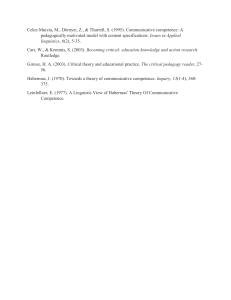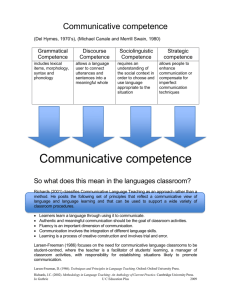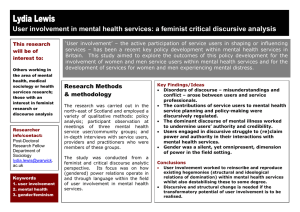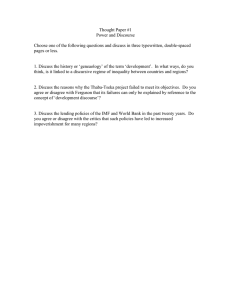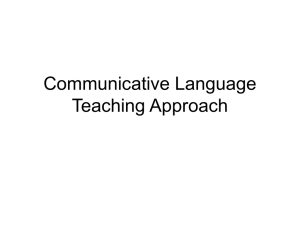Discourse Competence in Textile Students: Critical Thinking
advertisement
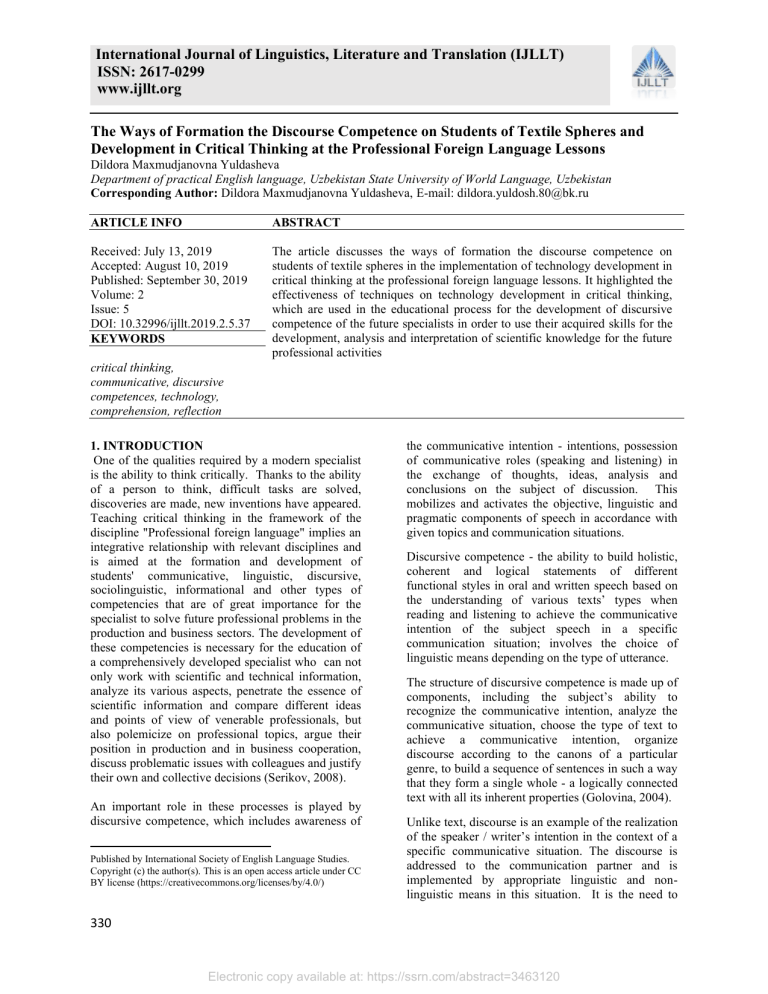
International Journal of Linguistics, Literature and Translation (IJLLT) ISSN: 2617-0299 www.ijllt.org The Ways of Formation the Discourse Competence on Students of Textile Spheres and Development in Critical Thinking at the Professional Foreign Language Lessons Dildora Maxmudjanovna Yuldasheva Department of practical English language, Uzbekistan State University of World Language, Uzbekistan Corresponding Author: Dildora Maxmudjanovna Yuldasheva, E-mail: dildora.yuldosh.80@bk.ru ARTICLE INFO ABSTRACT Received: July 13, 2019 Accepted: August 10, 2019 Published: September 30, 2019 Volume: 2 Issue: 5 DOI: 10.32996/ijllt.2019.2.5.37 KEYWORDS The article discusses the ways of formation the discourse competence on students of textile spheres in the implementation of technology development in critical thinking at the professional foreign language lessons. It highlighted the effectiveness of techniques on technology development in critical thinking, which are used in the educational process for the development of discursive competence of the future specialists in order to use their acquired skills for the development, analysis and interpretation of scientific knowledge for the future professional activities critical thinking, communicative, discursive competences, technology, comprehension, reflection 1. INTRODUCTION1 One of the qualities required by a modern specialist is the ability to think critically. Thanks to the ability of a person to think, difficult tasks are solved, discoveries are made, new inventions have appeared. Teaching critical thinking in the framework of the discipline "Professional foreign language" implies an integrative relationship with relevant disciplines and is aimed at the formation and development of students' communicative, linguistic, discursive, sociolinguistic, informational and other types of competencies that are of great importance for the specialist to solve future professional problems in the production and business sectors. The development of these competencies is necessary for the education of a comprehensively developed specialist who can not only work with scientific and technical information, analyze its various aspects, penetrate the essence of scientific information and compare different ideas and points of view of venerable professionals, but also polemicize on professional topics, argue their position in production and in business cooperation, discuss problematic issues with colleagues and justify their own and collective decisions (Serikov, 2008). An important role in these processes is played by discursive competence, which includes awareness of Published by International Society of English Language Studies. Copyright (c) the author(s). This is an open access article under CC BY license (https://creativecommons.org/licenses/by/4.0/) the communicative intention - intentions, possession of communicative roles (speaking and listening) in the exchange of thoughts, ideas, analysis and conclusions on the subject of discussion. This mobilizes and activates the objective, linguistic and pragmatic components of speech in accordance with given topics and communication situations. Discursive competence - the ability to build holistic, coherent and logical statements of different functional styles in oral and written speech based on the understanding of various texts’ types when reading and listening to achieve the communicative intention of the subject speech in a specific communication situation; involves the choice of linguistic means depending on the type of utterance. The structure of discursive competence is made up of components, including the subject’s ability to recognize the communicative intention, analyze the communicative situation, choose the type of text to achieve a communicative intention, organize discourse according to the canons of a particular genre, to build a sequence of sentences in such a way that they form a single whole - a logically connected text with all its inherent properties (Golovina, 2004). Unlike text, discourse is an example of the realization of the speaker / writer’s intention in the context of a specific communicative situation. The discourse is addressed to the communication partner and is implemented by appropriate linguistic and nonlinguistic means in this situation. It is the need to 330 Electronic copy available at: https://ssrn.com/abstract=3463120 IJLLT 2(5):330-333 create text that is the implementation of the communicative intention of the author in a specific communicative situation leads to the conclusion that discourse should be the unit of instruction - a text in a communication situation (Elukhina, 2002). In the process of teaching a professional language, the formation of discursive competence is facilitated by the work on texts in the specialty, based on which exercises are developed that develop speech skills. Speech exercises are closely related to three activities: mental (intellectual) - the development of the ability to formulate mental images and statements; in fact, speech - the development of the ability to form a statement; socio-behavioral - the ability to interact in the language being studied, taking into account a variety of situations (Elukhina, 2002). At the same time, it is effective to use critical thinking technology, which takes place in three stages: challenge, comprehension, and reflection. At the stage of a call, you can use such techniques to stimulate mental activity, to stimulate interest in obtaining new information and setting your own learning goals, like "Association", "Confused Logical Chains", "Brainstorm", "I Know. I want to know. I found out." At the stage of comprehension, the strategies “Simple and Complex Questions”, “Decision Tree”, “Clinic Methodology”, “Case Study” are effectively applied [4, р. 19...24]. These types of works contribute to the development of the ability to compare, highlight the general and distinctive features and characteristics of the subject, , phenomenon or process. At the stage of reflection, it is advisable to use the methods of compiling the "Cluster", "Сinquain", activating associative and logical connections. Such work methods enriches vocabulary to communicate, learn to formulate the idea of the text, prepare for a short retelling stimulate self search activities of students, allow each of them to feel like a creator. Therefore, independence is the first and perhaps most important characteristic of critical thinking (Ayaganova, 2001). Here are some examples: 1. Strategy of “Brainstorm” when introducing new terms, students are invited to formulate a definition for them. The topic "Textile materials science is ..." on the interactive whiteboard pictures are shown with the inscription: fabrics, knitwear, non-woven fabrics, yarn; words: structure, properties, quality assessment, application. Question: "What word can they associate with these pictures and phrases?". Students guess the word "textiles". As a result of the analysis and synthesis of the information are presented in the pictures, student must come to the conclusion that "Textile materials science is the science of the structure, properties, quality assessment of textile materials and their application for the manufacture of various types of products." Further, after reading the text, informative statements are compiled, in which informative unfold information messages of a descriptive, narrative, argumentative, analyzing type (Seydenova, 2013). 2. The "Association" method is suitable for studying words as close as possible to the natural processes of memorization. But this is all theory, it is interesting to see in practice how to apply the method of associations to study textile terminology . The method of association is one of the main methods for the development of memory. It is necessary to know about it, since it is very useful in itself, and is also an integral part of most memorization methods, including for studying foreign words. It is difficult to imagine any technique of memorization in general without this method. For example, an explanation of the textile process, the process of how to create fabric, from which materials are made? Each association will be very different from each other. If you ask everyone to answer what comes to their mind when mentioning the word “fiber”, you can get the following answers - “thread”, “cotton”, “material”, etc. It depends on the individual experience of each of the respondents. All these associations are formed in consciousness and are called free. To master the method of association, you just need to practice creating associative connections between any elements. (Golovina, 2004) 3. Method "Confused logical chains”, this "Logical Chain" has been known in the technique for a long time. It helps to remember and comprehend a large amount of information, to reveal the regularity of any events, phenomena. The technique works on the development of critical thinking, the development of memory and the ability to think logically. The Logical Chains method can be used in lessons in all subjects and at any stage of the lesson. It all depends on the goals that the teacher sets. The strategy is to build a chain of facts, sentences, words, terms, process, dates, rules, quotes in a logical or chronological order. The construction of the logical chain can be carried out together with the teacher, in groups / pairs in the lesson, can be offered as an independent work or homework. For example, in English lessons, the fiber process is studied before creating a fabric, and remember all the key terms. Leaners offer to make a logical chain and record all the important points from fiber to fabric - ginning process, spinning, weaving, bleaching, finishing, and 331 Electronic copy available at: https://ssrn.com/abstract=3463120 The Ways of Formation the Discourse Competence on Students of Textile Spheres and Development in Critical Thinking at the Professional Foreign Language Lessons printing. After composing the chain, it is important that students can decipher each process. To facilitate each process can be supplemented with these facts Elukhina, 2002) 4. It is useful “Decision Tree” technology, the class is divided into 3 or 4 groups with the same number of students. Each group discusses the issue and makes notes on its “tree” (a large sheet of paper), then the groups change places and add their ideas on the trees of the neighbors without criticizing or correcting the ones already on the sheet. You can change groups in a circle, you can stop at a certain number of “advisers”. The leader of group processes the additions, proposes its final decision on this issue, we conduct a discussion, sometimes developing into a debate between the parties (especially when discussing some contentious or controversial issues). The decision tree can be used to discuss the pros (one group) and the cons (second group) of a certain issue (Ayaganova, 2001) information in groups, pairs. Read the text drawn up by verification statements (polemical, convincing to refute). 8. Method of «Writing an essay." The meaning of this technique can be expressed in the following words: "I write in order to understand what I think." This is a free letter on a given topic, in which independence, manifestation of personality, discussion, originality of solving a problem, argumentation are valued. At the reflection stage, it can give a task - based on the proposed material, write an article in the scientific journal for students of technical universities on the topic "What do we know about the textile industry?" In all types of tasks, the text acts as a product of speech and thought activity and as a material for perception. 5 When using the "clinic technique", each of the participants develops his own solution, having previously submitted for open discussion his “diagnosis” of the problematic situation posed, then this decision is evaluated as a leader, and a group of experts specially designated for this purpose on a point scale or according to a pre-adopted system of "accepted - not accepted". The importance of the functional and pragmatic aspects in the study of the text as the basis for the search the optimal variant of its speech organization is emphasized. Each exercise to a certain extent develops all aspects of discursive competence and, therefore, speech skills. Students are performing these exercises and trained to inform, report on what they read; pay attention to specific information, explain using professional terminology; express a point of view, formulate ideas; express approval, support; object, disagree, criticize; to insist, persuade, prove. 6. The strategy of “Cluster” is used to introduce the concept of Textile Materials. Students are encouraged to "jumble" around a given phrase words, phrases or sentences expressing ideas, facts and images associated associatively or logically with the proposed phrase. Name own associations to the phrase "Textile Materials". Based on previous knowledge and depending on the degree of preparedness, students call words and phrases: fibers, threads, yarn, products, factory, constructor, fashion designer, design. What are Textile Materials? Define this term (Baranova, 2008) In the process of the formation in Russian-language and Uzbek-language discursive competence through the development of critical thinking technology, such a professional quality of personality is laid, as the ability to think critically, which is characterized by openness, flexibility, reflectivity, the ability to find independently and defend new ideas, justify their own choice of decisions and discuss the results of their activities. The speech exercises are used for this contribute to improving the communication skills of students necessary for their future professional activities. Next, the terms are written out of the text, a dialogue is made on the content of the text using these terms and thesis to the text. Students determine what information should be added to the text and indicate information that is already known and new to them. REFERENCES 7. Method of "Basket of ideas, concepts" allows you to find out everything that students know or think on the topic under discussion. On an interactive whiteboard is drawing or basket icon. There is an exchange of information on the procedure: What is known about a particular problem? They record everything what know on the topic. Exchange of [1] Ayaganova, Sh. (2011). The use of critical thinking technology in the educational process. Administrator at the Kazakhstan school. - 2011, No. 1. P. 19- 24. [2] Baranova, N. A. (2008). Osnovy formirovaniya diskursivnoye kompetentsii studentov pri obuchenii inoyazychnomu professionalno-oriyentirovannomu obshcheniyu:[The fundamentals of the formation of students ‘discursive competence in teaching foreign language vocational oriented learning]. 332 Electronic copy available at: https://ssrn.com/abstract=3463120 IJLLT 2(5):330-333 dissertatsiya... kandidata pedagogicheskikh nauk: 13.00. 08/Baranova Natal'ya Aleksandrovna. [3] Elukhina, N. V. (2002). The role of discourse in multicultural communication and methods of forming the discursive competence. Foreign languages at school, 3, 9-13. [4] Golovina, (2004). Golovina N.P. (2004). Forming discourse competence in high schoolers while instructing for producing and reproducing foreign language texts: school specializing in the English language: diss. … PhD (Pedagogics): 13.00.02. Saint Petersburg. [5] Serikov, V. V. (2008). Education as a kind of educational activity. Moscow: Academy Press. 256p. [6] Seydenova S. D., Almatyova N. A. (2013). Professional Russian language. - Almaty: ATU Publishing Department. 333 Electronic copy available at: https://ssrn.com/abstract=3463120
